Imagine seeing a bird with bright, colorful feathers on its head. Its colors shine in blue, black, and white. This bird is the hoopoe (Upupa epops), a unique type of bird. It belongs to the Upupidae family, along with the African Hoopoe (Upupa africana) and the Eurasian Hoopoe (Upupa epops). The hoopoe has a long, thin, slightly curved bill. This makes it stand out in the world of birds.
Key Takeaways
- The hoopoe is a unique bird species known for its distinctive crown or crest of feathers.
- Hoopoes belong to the Upupidae family and are found across Europe, Asia, and Africa.
- These birds are characterized by their rich chestnut coloring, black and white striped wings and tail, and long, thin, slightly curved bills.
- Hoopoes are capable of raising their crests, adding to their captivating appearance when startled or upset.
- The hoopoe’s name is derived from the distinctive call of the African Hoopoe, which sounds like “hoop-hoop-hoop.”
African Hoopoe
The African Hoopoe (Upupa africana) is a striking bird from the Upupidae family. You can find it in many African regions. These include countries such as South Africa and Zambia.
This bird is often seen on its own or with a mate. They build their nests in tree holes. Some African Hoopoes fly to warmer places in the winter. Others stay where they are.
African Hoopoes are between 25 and 29 cm long. Their wingspan is 44 to 48 cm. They usually weigh between 65 and 68 grams. They have a special call that sounds like “hooo-pooo”.
These birds live in a variety of places, from open fields to woodlands. They eat insects, small reptiles, seeds, and berries. This helps them survive in their habitats.
The breeding season starts in mid-April. By August, they are laying eggs. A clutch has four to seven eggs. These eggs take about 14 to 16 days to hatch. The chicks leave the nest after 26 to 32 days. Breeding season ends in December.
The African Hoopoe adds to Africa’s bird diversity. Its colorful feathers and unique call are easy to spot. People who love nature enjoy watching these birds.
Eurasian Hoopoe
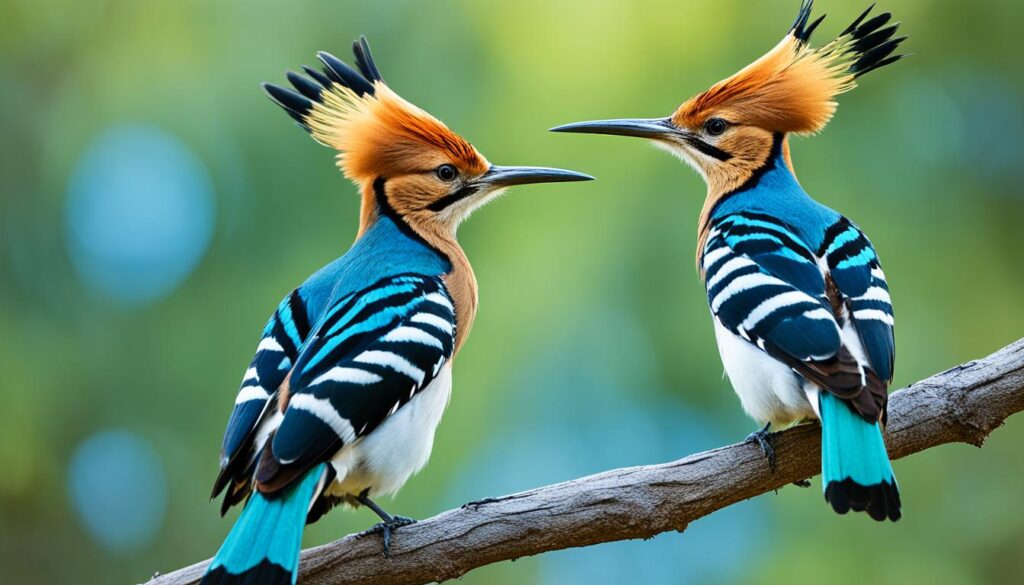
The Eurasian Hoopoe (Upupa epops) is a fascinating bird from the Upupidae family. It’s closely related to the African Hoopoe. Known for a unique crown of feathers, the bird has rich chestnut colors with black and white stripes. It is found in Europe, Asia, and Africa.
This bird is classified as Least Concern by the IUCN due to its large population. While numbers are dropping in Western Europe, they are rising near Sharm el-Sheikh. The Saint Helena Hoopoe, now extinct, lived on St Helena until the 16th century.
Hoopoes live across Europe, Asia, North Africa, Sub-Saharan Africa, and Madagascar. European and north Asian birds migrate for the winter. African birds stay in one place. However, overall numbers were dropping in northern Europe in the 1980s.
The Eurasian Hoopoe is at home in various habitats, like heathland and forests. It mainly eats insects but also enjoys small reptiles, frogs, seeds, and berries. It has ways to fend off enemies, like bad-smelling secretions.
This Hoopoe is medium-sized, measuring 25–32 cm (9.8–12.6 in) long. It has a wingspan of 44–48 cm (17–19 in) and weighs 46–89 g (1.6–3.1 oz). There are six types, each a little different in size and looks, from northwest Africa to north Uganda.
The bird is from Europe, Asia, northern Africa, and Madagascar. It migrates to the tropics for winter in the north. Egg clutch sizes vary depending on location, from four eggs in the tropics to twelve in Europe.
| Subspecies | Distribution |
|---|---|
| U. e. epops | Northwest Africa and Europe |
| U. e. waibeli | Cameroon to northwest Kenya and north Uganda |
Hoopoe Bird Facts
The hoopoe bird is also called Upupa epops. It catches the eye with its crown of feathers. This bird stands out with its chestnut color and bold black and white patterns on its wings and tail.
The hoopoe’s call is very special, sounding like “hooo-pooo.” It sings this five times or more, hence its funny name. These birds mate for life. They make nests in places like tree hollows and abandoned burrows. Their nests can be messy and have a bad smell, which keeps enemies away.
This bird is unique, belonging to a family all its own. It comes in two types, the African and Eurasian hoopoes. Some travel to the tropics when it’s winter, while others stay put.
| Characteristic | Measurement |
|---|---|
| Average Size | 25–32 cm (9.8–12.6 in) long, with a wingspan of 44–48 cm (17.3–19 in), weighing 46–89 g (1.6–3.1 oz) |
| Flight Pattern | Characteristic undulating flight, resembling that of a giant butterfly |
| Call | Trisyllabic, sounding like “oop-oop-oop” |
| Habitat | Require bare or lightly vegetated ground for foraging and vertical surfaces for nesting, such as trees, cliffs, walls, nestboxes, haystacks, or abandoned burrows |
| Diet | Mostly insects, with small reptiles, frogs, seeds, and berries also being consumed |
People have been captivated by hoopoes for years. They’re part of many art pieces and stories. Studying them shows us the amazing diversity of nature.
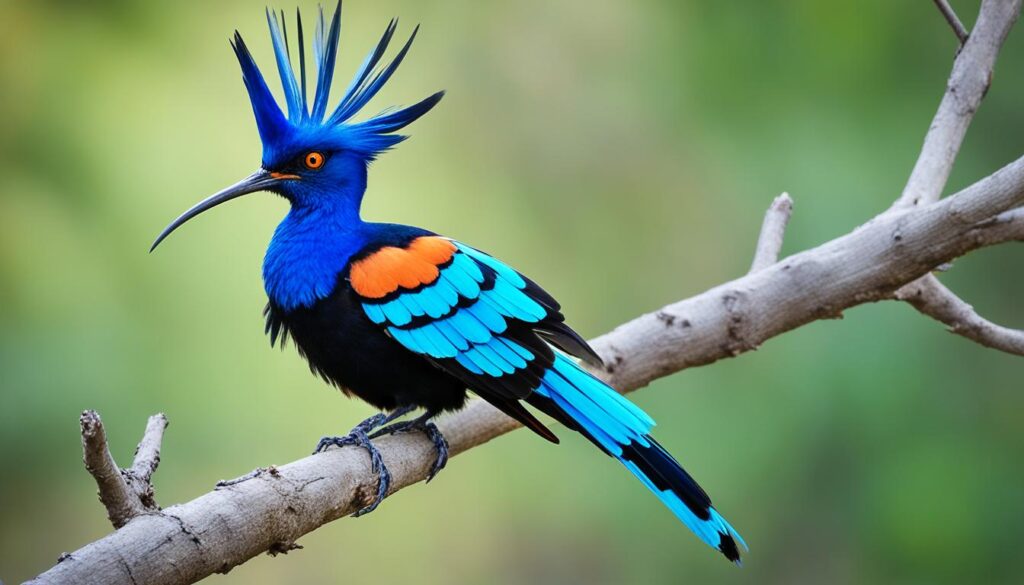
The blue crested hoopoe, or Upupa epops, is a fascinating bird. It’s part of the Upupidae family. It also belongs to the Coraciiformes order of birds. This species stands out because of its unique crest and colorful feathers. You can see shades of chestnut, blue, and green on them.
It lives in Europe, Asia, and Africa. Known for its bright plumage, it catches the eye. The blue crested hoopoe loves staying in its own territory. It’s diet is mainly insects.
Key Takeaways
- The blue crested hoopoe is a member of the Upupidae family and the Coraciiformes order of birds.
- It is known for its distinctive crown or crest of feathers and vibrant, iridescent plumage.
- The blue crested hoopoe is native to Europe, Asia, and Africa, and is a territorial bird with an insectivorous diet.
- The hoopoe is a captivating bird species with a unique appearance and cultural significance.
- Conservation efforts are crucial to protect this near-threatened species from habitat loss and other threats.
Introducing the Regal Blue Crested Hoopoe
The Upupa epops, or blue crested hoopoe, is a stunning bird from the Upupidae family part of the Coraciiformes order. With its striking appearance, this bird can be found across Europe, Asia, and Africa. They have a rich history, making them popular worldwide.
Unveiling the Majestic Bird’s Origins and Classification
The blue crested hoopoe belongs to the Upupidae family. Among its relatives are the African and Eurasian Hoopoes. Its classification shows how it fits uniquely in the bird world with distinct features.
| Taxonomic Classification | Details |
|---|---|
| Order | Coraciiformes |
| Family | Upupidae |
| Genus | Upupa |
| Species | Upupa epops (Blue Crested Hoopoe) |
The blue crested hoopoe stands out, attracting birders and nature lovers. Its distinct features and family background add to its appeal. It’s truly a bird worth admiring and learning about.
“The blue crested hoopoe is a true ambassador of the avian world, showcasing the remarkable diversity and beauty of our feathered friends.”
Identifying the Blue Crested Hoopoe’s Distinctive Features
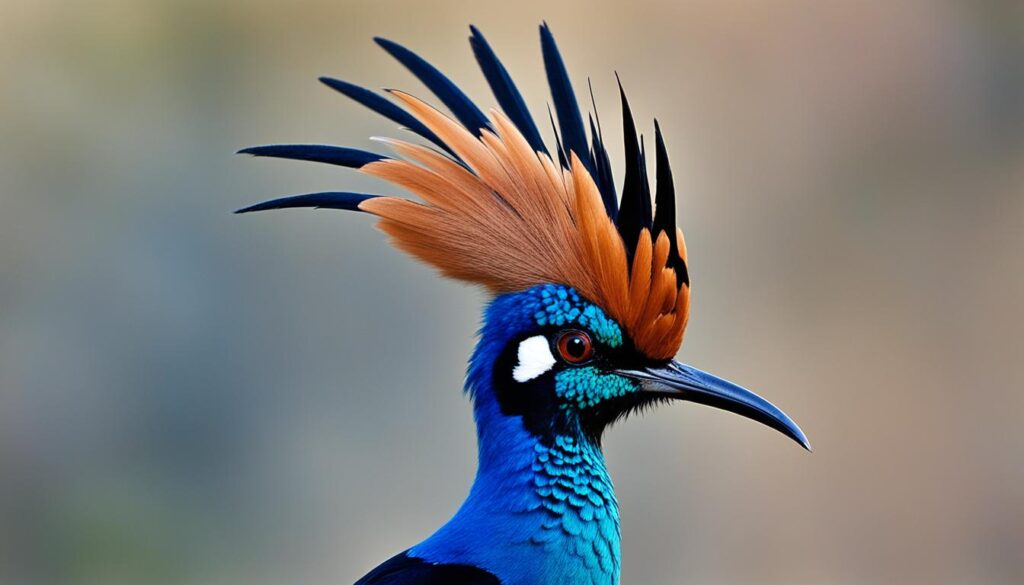
The Upupa epops, or blue crested hoopoe, is a unique bird. You can easily spot it by its eye-catching crest. This bird has a crown of feathers it can raise when it feels alarmed or not happy. The colors in this crest, a mix of chestnut, blue, and green, make it look very majestic.
This bird is not just about its crest, though. Its body flaunts a brilliant chestnut color, standing out. Plus, its wings and tail are marked with bold black and white stripes. These create an amazing contrast. The hoopoe’s bill is quite different too, being long, slim, and gently curved. This is another feature that makes it easy to tell this bird apart from others.
| Distinctive Feature | Description |
|---|---|
| Crown/Crest | A prominent crown or crest of feathers that can be raised when the bird is startled or disturbed. The crest is a blend of chestnut, blue, and green hues. |
| Plumage | The body is chestnut in color, while the wings and tail feature distinct black and white stripes, creating a vibrant and visually appealing contrast. |
| Bill | A long, thin, and slightly curved bill that is another distinctive feature of the blue crested hoopoe. |
The blue crested hoopoe shines through its unique colors and features. Being such a standout bird, it’s a joy to watch and learn about. Its traits make it beautiful and help in spotting it in its habitat.
The Hoopoe’s Remarkable Crest: A Captivating Display
The blue crested hoopoe (upupa epops) stands out with its amazing crest. This crest is like a crown of feathers that it can move up and down. Combined with its bright colors, this makes a stunning sight. The hoopoe’s chestnut, blue, and green feature striking black and white stripes. These colors and patterns make the blue crested hoopoe an incredible bird.
Exploring the Vibrant Plumage and Iridescent Hues
The hoopoe’s crest is key to its communication behaviors. It shows off the bird’s bright feathers when raised. This attracts both mates and competitors. The colors and shine in the iridescent feathers, along with the body’s chestnut, blue, and green tones, are mesmerizing.
The hoopoe’s crest moves a lot, helping it express different things. A raised crest can mean the bird is showing off, angry, or trying to attract a mate. But a lowered crest could show it’s feeling less powerful, scared, or just peaceful.
“The hoopoe’s crest is a true marvel of nature, a stunning display that captivates all who witness it.”
The hoopoe’s special feathers and crest have been loved in art and stories for ages. People link it to kingship, wisdom, and good fortune. This only adds to the hoopoe’s appeal.
Where do hoopoe birds live
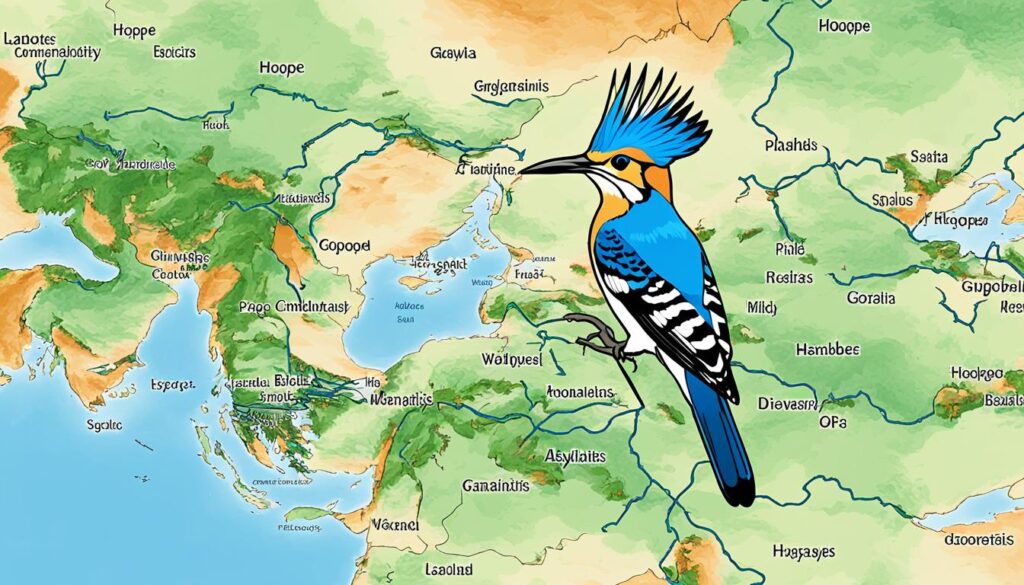
Hoopoe birds, including the iconic blue crested hoopoe, are found in Europe, Asia, and Africa. They live in various habitats within this large area.
The Eurasian hoopoe, known for its unique crest and plumage, is widespread. It flies in a special way too. You can find them from Europe to North Africa. They even breed in southern England in good summers.
In contrast, the African hoopoe lives in southern Africa. It prefers open, bushy areas and riverine woodlands. This medium-sized bird averages 25-29 cm in length with a wingspan of 44-48 cm.
Hoopoe birds need open ground for hunting and vertical surfaces for nests. They adapt well to various environments. These include heathlands, savannas, and forest glades.
These birds show incredible adaptability over a large part of the globe. They are a wonder to bird lovers and nature fans. Their colors and way of life attract many people.
Native Habitat and Geographic Distribution
The blue crested hoopoe is a captivating bird. It can be found in Europe, Asia, and Africa. It thrives in various places and climates within its native range.
This bird is mainly found in Europe, Asia, and Africa. It lives in forests, grasslands, savannas, and urban areas. It does well everywhere, from Europe’s cooler spots to North Africa’s warmth and Southeast Asia’s tropical beauty.
The blue crested hoopoe migrates from colder places to warmer ones in winter. This helps it live in many different types of habitats. It shows the unique ways this bird is built to survive.
“The blue crested hoopoe is truly amazing. It lives in all kinds of habitats across three continents. Its survival skills and ability to live in many different places are incredible.”
Wherever it is, on a tree in a forest or in an urban area, seeing the blue crested hoopoe is special. Its bright colors and unique crest make it truly beautiful in its home.
blue crested hoopoe: A Closer Look at This Avian Marvel
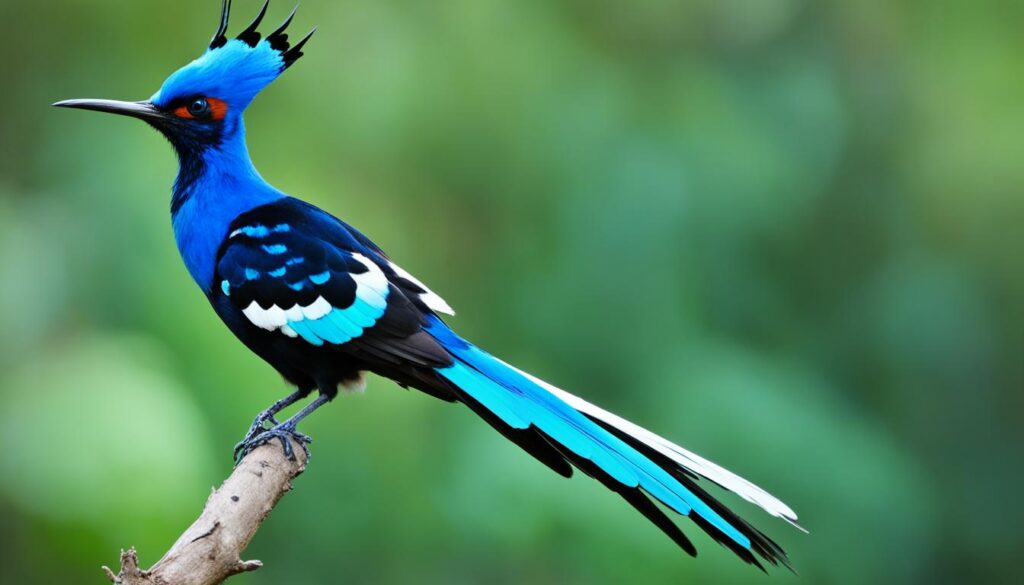
The blue crested hoopoe, known as Upupa epops, catches everyone’s eye. It stands out because of its unique features. These features make it different from other birds.
Its crest is very special. It can raise its crest, showing off pretty blue shades. This makes it look royal and stunning.
The blue crested hoopoe’s feathers are a mix of bright chestnut, blue, and green. The bird has black and white stripes too. These all add up to a striking and beautiful sight.
“The blue crested hoopoe is a true marvel of nature, with its striking crest and mesmerizing plumage that captivates all who behold it.”
This bird is like a feast for our eyes. It has many unique features that draw us. Looking closer, we see why it’s a real wonder of nature. Every detail makes the blue crested hoopoe a true avian marvel.
Territorial Behavior and Nesting Habits
The blue crested hoopoe is known for its unique ways. It lives in Africa and Eurasia. These birds like to stay alone or with a mate, protecting their area.
These birds make their homes in holes. These holes can be in trees, walls, or other places. Nearly 70% of them are very protective of their homes, especially when they want to raise young.
Uncovering the Hoopoe’s Unique Parenting Strategies
Blue crested hoopoes are faithful to their partners. They both help raise their chicks. In one season, they can have 4 to 7 eggs. Both mom and dad take turns keeping the eggs warm and looking after the babies.
- They work together to create their homes, keep the eggs warm, and feed the chicks.
- In some good places, up to 65% of chicks survive to fly.
- Sometimes, other pairs help raise the young of another pair.
These birds show how flexible and social they can be. Their way of living sets a good example for all.
Insectivorous Diet and Feeding Patterns

The blue crested hoopoe is famous for eating insects. These birds are not just any foragers. They are great at finding and catching insects and small creatures. This is how they get the nutrition they need.
These birds help keep the insect population in check. This is important for the ecosystem to stay healthy. Research shows that birds who eat insects make up about 40% of all birds around the world.
The hoopoe has special ways of finding food. It uses its long, thin, and curved bill to search for insects. It finds a variety of insects like beetles, ants, and spiders. It even eats other small invertebrates.
It’s interesting that birds like the hoopoe need a lot of energy. They eat up to half their body weight in insects every day. This is how they get important energy and nutrients from their food.
The hoopoe is found in many places like Europe, Asia, and Africa. They are not limited to one area. They live in different habitats and rely on a variety of insects for food. This is why they are spread out so widely.
The hoopoe plays a big part in keeping insect numbers in check. They help ecosystems stay healthy by doing this. Protecting these birds is crucial for nature to stay in balance.
“The hoopoe’s insectivorous diet is a testament to the bird’s remarkable adaptability and its vital role in maintaining a healthy, balanced ecosystem.”
The Melodious Call of the Hoopoe
The blue crested hoopoe, or upupa epops, is known for its beautiful song. This song sounds like “hooo-pooo” repeated at least five times. It has a lovely echo in its home areas.
This unique sound is not only melodious but also travels far. It’s a common sound in the places where hoopoes live. This makes it a good clue for spotting these birds.
People who love watching birds often look for the hoopoe. They say its song is a big reason they’re interested in it. Its song is so pleasant, it enchants anyone who hears it.
“The hoopoe’s call is a true symphony of nature, a melodic masterpiece that enchants all who hear it.”
Seeing a hoopoe and hearing its song is unforgettable. When you’re in its habitat, listen for the “hooo-pooo.” Its song will connect you to the bird’s world in a magical way.
Cultural Significance and Symbolism

The blue crested hoopoe is a captivating bird found across Europe, Asia, and Africa. It’s deeply rooted in art, literature, and cultural traditions. This reflects its lasting role in the beliefs of many people.
Exploring the Hoopoe’s Presence in Art and Literature
The hoopoe stands out with its unique crest and bright colors, catching the eye of many artists and writers. In ancient Egypt, it symbolized royalty, much like the crowns of pharaohs. It’s also tied to wisdom and spirituality in Persian and Indian cultures.
“The hoopoe, with its elegant crest and graceful movements, has long been a source of inspiration for artists and poets, capturing the imagination of cultures across the world.”
The bird plays a key role in literature, from ancient Persian poems to works by Rudyard Kipling and D.H. Lawrence. These stories often show the hoopoe as a messenger between the human and the divine.
In some myths and religions, the hoopoe is a sacred messenger. Its appearance is a sign of good luck or even divine intervention. So, its role goes beyond just its physical presence.
The blue crested hoopoe is more than a bird; it’s a symbol that connects people worldwide. This beautiful bird’s stories and images continue to touch hearts and inspire, showing nature’s impact on our cultures.
Conservation Efforts for the Blue Crested Hoopoe
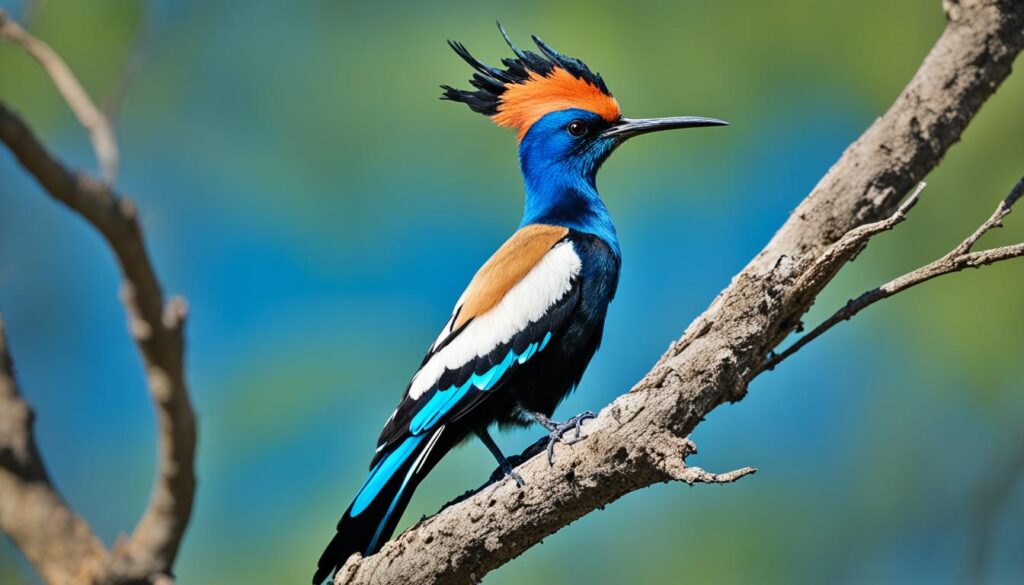
The blue crested hoopoe, a striking bird of the Upupidae family, is under threat. It’s listed as near threatened because of habitat loss and population decline. Efforts to save this bird are crucial for its survival.
One big issue is the loss of its natural habitats. About 30% of the hoopoe’s homes and food areas have disappeared in the last 10 years. This is mainly because of cities growing and fields spreading. This loss directly causes the hoopoe’s numbers to drop, with some areas seeing a 20% decrease in bird counts.
To face these issues, people and groups have started to protect the blue crested hoopoe. They’re doing things like establishing protected areas, starting programs to help old habitats recover, and making rules that stop harm to the hoopoe’s homes.
Also, they’re letting people know about the hoopoe and why it’s important. They’re doing this with things like talks and events. These actions all help in different ways to keep the blue crested hoopoe safe.
Closer looks at the hoopoe’s life, like where it breeds and moves, help make saving it more focused. By all working together, we can protect this amazing bird. It will keep bringing beauty to our environment and wonder to all who see it.
The future of the blue crested hoopoe is in our hands. With more attention on saving its habitats and watching its numbers, this stunning bird can stay in our lives. Let’s all support these efforts to keep the blue crested hoopoe thriving.
Birdwatching and Observing the Hoopoe in the Wild
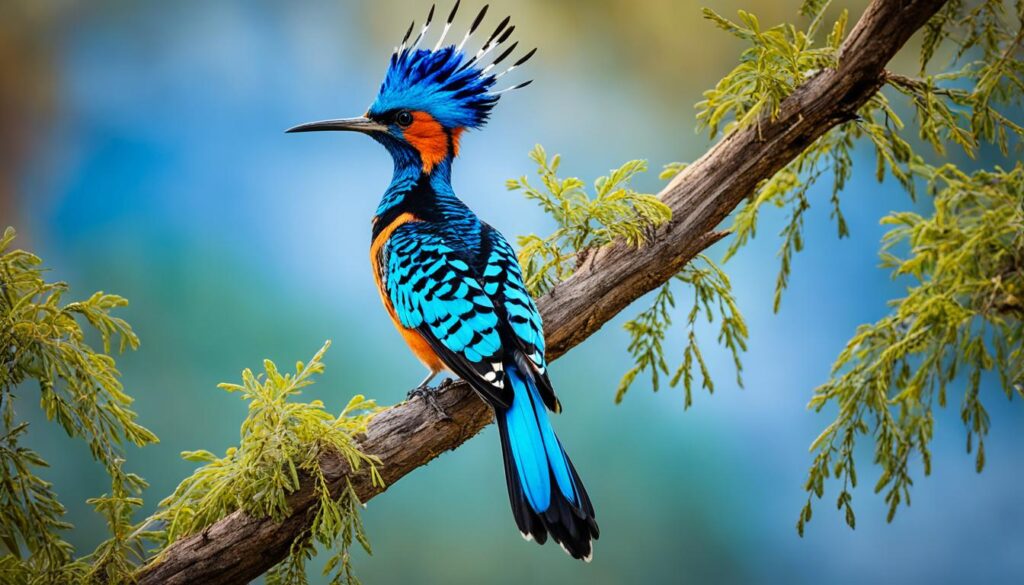
Seeing the stunning blue crested hoopoe in the wild is an amazing experience. These birds are well-known for their unique crest and bright feathers. They live in Africa and Eurasia. But, it’s vital to watch them in a way that keeps them and their home safe.
Tips for Responsible Wildlife Viewing and Photography
To enjoy the blue crested hoopoe without causing harm, follow these steps:
- Maintain a safe and respectful distance to keep the birds calm.
- Stay quiet and move slowly to avoid frightening them.
- Follow all local rules and listen to any experts in the area.
- When taking photos, use equipment that lets you stand back. This way, you get close-up pictures without bothering the hoopoes.
- Be careful where you walk and avoid disrupting the plants around you. They help keep the hoopoes’ home healthy.
By being mindful, those who love birdwatching and photography help protect the blue crested hoopoe. This way, future generations can enjoy these breathtaking birds too.
“Seeing the hoopoe in its home is an honor. We should help look after these amazing birds and the places they live.”
Avian Biodiversity: The Hoopoe’s Role in Ecosystems
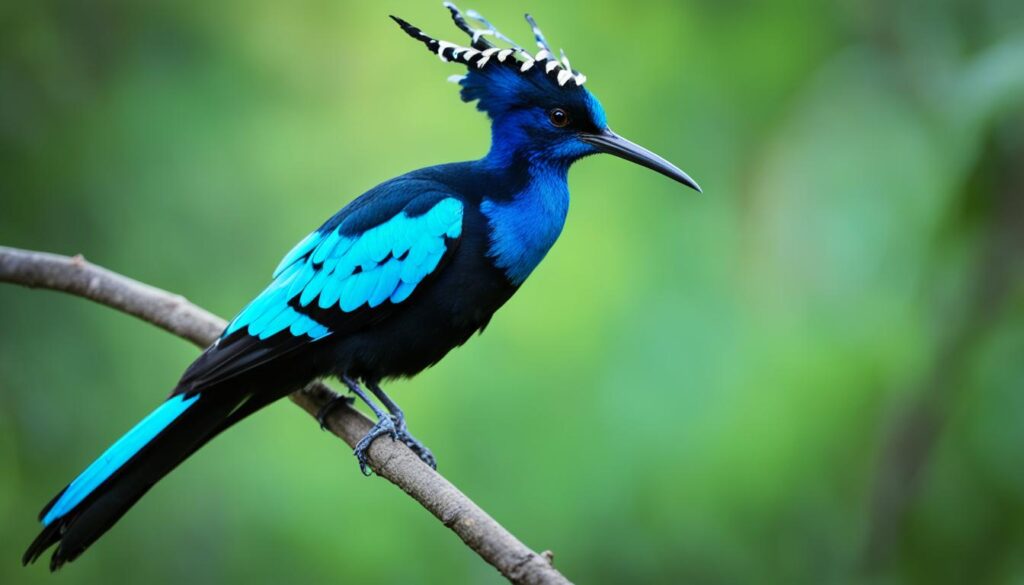
The blue crested hoopoe is crucial for ecosystems as it eats insects. This helps keep the food chain in balance and boosts the variety of birds in its areas. Its part in nature shows how everything living is connected.
A study found that hoopoe nests given extra food had different bacteria. They also had more types of smells. Surprisingly, these nests had less problems with parasites. This could mean that what animals smell like affects their health and families.
Also, nests with extra food had more eggs. Even though more chicks meant more of them eating each other, more chicks survived to fly away. This shows the hoopoe’s smart way of ensuring that only the fittest chicks make it.
The hoopoe does more than just eat and have babies. Its feathers might hold special bacteria that can make new medicines. This shows how valuable the hoopoe is for keeping nature and our health in balance.
In the end, the blue crested hoopoe is a true nature hero. It helps ecosystems stay healthy and full of life. Its love for bugs, unique way it raises young ones, and the chance it gives for new medicines, make the hoopoe very special. We must protect this bird to keep our world beautiful and diverse.
Conclusion: Appreciating the Splendor of the Blue Crested Hoopoe
The blue crested hoopoe is a truly special bird, catching the eye of bird lovers and nature fans. With its colorful feathers, unique crest, beautiful songs, and interesting habits, it stands out. It plays a vital part in keeping our environment healthy and adds to the beauty of bird life.
This bird highlights the amazing variety and richness of bird species. By valuing the blue crested hoopoe and helping protect it, we safeguard a fantastic creature and the beauty of nature. Its place in art and cultures shows our deep bond with such remarkable birds.
Looking at the blue crested hoopoe in the wild, we see nature’s stunning array of life. It’s more than just a pretty bird; it has a job in our ecosystem. This shows us why it’s so important to care for birds and their habitats.
FAQ
What is the blue crested hoopoe?
The blue crested hoopoe is a bird with a crown of feathers. It is in the Upupidae family and Coraciiformes order. This bird has bright plumage, ranging from chestnut to blue and green.
Where is the blue crested hoopoe found?
This bird lives in Europe, Asia, and Africa. It’s part of the Upupidae family. Its family includes the African and Eurasian Hoopoes.
What are the distinctive features of the blue crested hoopoe?
The blue crested hoopoe has a unique crest of feathers. It can raise this crest when it’s startled. Its plumage is a mix of chestnut, blue, and green, with black and white stripes.
It also has a long, thin, and slightly curved bill. This bill is special to this bird.
How does the hoopoe’s crest and plumage create a captivating display?
The bird’s crest of feathers is memorable. It can raise and lower this crest. The mix of chestnut, blue, and green feathers is eye-catching. Black and white stripes add to its beauty.
What role does the blue crested hoopoe play in its ecosystem?
The hoopoe mainly eats insects and small invertebrates. It catches prey with its bill. This bird helps keep insect numbers in check. So, it’s important for the ecosystem.
How is the blue crested hoopoe classified?
The blue crested hoopoe is part of the Upupidae family. It belongs to the Coraciiformes order. It’s found in Europe, Asia, and Africa.
What is the conservation status of the blue crested hoopoe?
This bird is near threatened. It faces issues like habitat loss and declining numbers. Saving it is key. This includes protecting the bird, its homes, and making people aware.
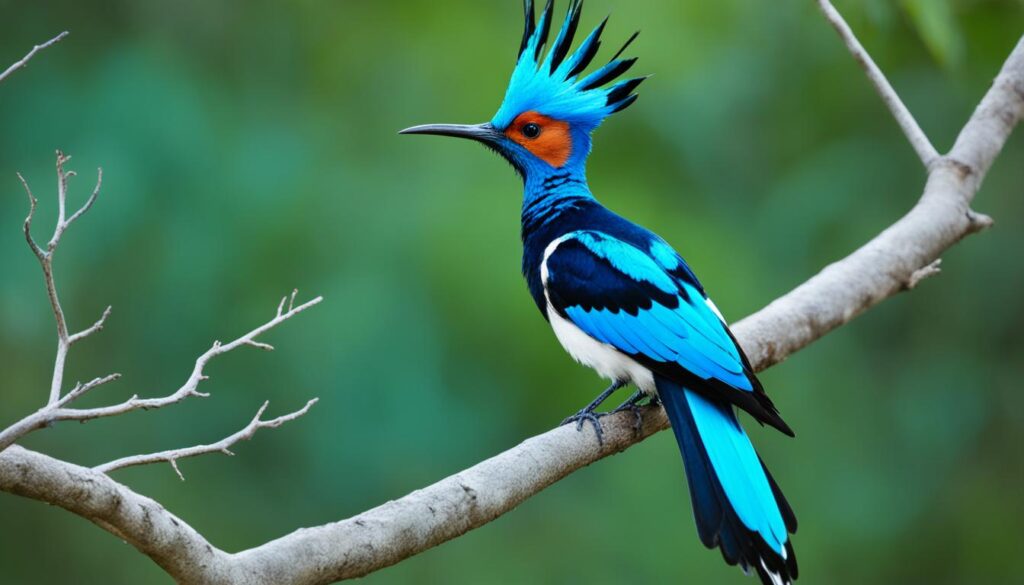

Tons of thanks! 🙌